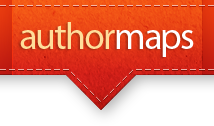Covers and Thumbnail Images
Book covers and branding
In Slider One on Authormaps, “Branding Your Book,” I pointed out that defining the genre of your book is the first step in creating a brand for yourself and your book. The genre of a book is defined by its broad subject, its language, the age level of its readers, whether it is fiction or non-fiction and/or its subject.
A few examples of genres are: romances, mysteries, science fiction, vampire tales, how-to guides, textbooks, biographies, autobiographies, children’s books, young adult books, poetry chapbooks, and scholarly books.
You’ll want to make sure that the genre of your book is made clear by its title, cover image, and your marketing materials. Branding is achieved with the unique images and words that distinguish your book from others like it.
If you create a book series, their covers should be similar enough to alert readers that a new book in the series is out.
In addition, if you’re a self-publisher, you may want to design a logo and name for use as your own publishing imprint for your book. That image too will help brand you and your book(s).
Book covers and book discovery
A book’s cover is often the first thing that prospective buyers will see. These days, a book-cover thumbnail online is the most likely thing a purchaser will notice. Your thumbnail has to be readable and the meaning of its smaller image easily deciphered.
This is one reason the use of various fonts on a self-published book cover is an amateur mistake. So is the inclusion of a long title, and/or wordy subtitle for the book. (For more about creating a book title, please see “Spice Up Your Book’s Title“.)
In addition, if you’re hoping to sell your book to libraries, a long title may kill sales you might make from patrons who fail to notice your book on the shelves when they browse a subject.
That’s because most print books and audiobook CD cases are displayed in the library with only their spines visible.
Libraries often attach the call number to the bottom of a book spine or CD case. This label cuts off any title that extends into that bottom inch and a half of the spine.
On the other hand, if you are an author with a publisher, the publisher may put their own branding needs and/or budget above your need for an cover image you believe will really help sell your book. This is an issue worth fighting for, but you will be unlikely to win.
It’s better to look for a publisher who will work with you on finding the right image(s) for your book’s cover and promotions.
Book cover keywords — the key to promotion
A listing for your book on an online book site or via a distributor’s or publisher’s catalog doesn’t mean automatic sales of your book to readers or libraries. Both groups are highly-selective in choosing books they want. Librarians, in particular must buy books for their particular communities. Financial constraints also affect librarians’ decisions.
Your most important tool for selling your books to librarians and and other book-lovers are the cover photos and thumbnail images for it. Your cover design should be professional-looking and attractive. And here’s why your choice of keywords for your book’s title is vital.
Keywords from the title are crucial to making your book more discoverable at libraries as well as bookstores, or online sites such as WorldCat (the largest online listing of library books), iBooks, Amazon, Barnes & Noble, etc.
For example, let’s suppose that someone has asked a librarian about Croatian recipes or even heard about our hypothetical cookbook, Croatian Cooking for Catholic Holidays; Meals for Family and Friends to Enjoy Together.
You could find this book if it’s in your library by using two or three of its keywords to search your library’s online catalog. If it’s at other libraries as well you could find them by using WorldCat’s Search box. What are this cookbook’s keywords? They are “Croatian,” “Cooking,” ” Catholic,” “Holidays,” and/or “Family”.
How libraries impact sales of books
According to Jeremy Greenfield’s “Library Patrons Buy Books They Borrow, Study Says,” nearly a fifth of library patrons visit the library often. 33% of these “power users” are using the library to find new information; 40% percent purchased a book they discovered there; about 67% purchased a book by an author they found at the library.
For every two books power patrons borrow, they buy one. Two thirds of power users of the library buy books they’d previously borrowed from it.
While many library patrons buy books they discover at the library, still others tell family members, friends and coworkers about a library book they liked, and those people may buy your book.
Not only could you sell your book to libraries – libraries can help you sell your book too. This is why the library market shouldn’t be ignored if you want to sell your book. There are only around 12,703 bookstores in the United States while there are over 120,000 libraries in the US alone.






